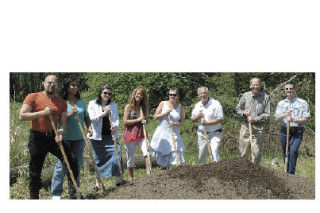MARYSVILLE — School Board President Cindy Erickson talked about how this particular day was more than a decade in the making.
Long before she was a member of the school board, Erickson said she attended a PTSA meeting as a parent and heard about how the district’s number one need was for a new high school. Nevertheless, voters waited until 2006 to pass a $79 million bond issue to support construction of what will be Marysville Getchell High School. Local officials expect the state to pitch in approximately $16 million, making the total project cost about $96 million.
On what was easily the warmest day of the year so far, city and school officials held a ceremonial groundbreaking for the new campus on May 17. Actual construction should start in early June on the 84th Street school, according to district Capital Projects Director John Bingham.
During his comments to a small crowd of onlookers, Superintendent Larry Nyland said the district had to go to voters a couple of times before earning passage of the bond issue. Chair of a specially created bond oversight committee, Chris Nation vowed his group would continue to monitor construction, trying to ensure the project comes in on time and on budget.
Nation joked when the school was first discussed, local homes cost about an average of $113,000 and something called Windows was beginning to appear as a computer operating system.
Nyland said while the final outcome depends on a number of factors from permitting to weather, officials are aiming to open Getchell in late 2010, a year earlier than was initially promised.
“That’s our goal, but it’s ambitious,” Nyland said. “We know it’s ambitious.”
“When completed these buildings will be more than steel,” said Getchell’s Planning Principal Tracy Suchan Toothaker. “They will be schools.” She further talked about “many tomorrows filled with laughter and learning.”
Consisting of 193,000- square-feet, the new school will encompass five main buildings. Four each will house one of the district’s smaller learning communities. The fifth will consist of a centralized cafeteria, a gymnasium, administrative offices and similar shared facilities.
Overall, the campus will house some 1,600 students.
The district moved to small learning communities this year. In the past, Nyland has said the idea is to engage students with topics that hold their interest and to build close relationships between students and staff. At present, the existing Marysville-Pilchuck High School integrates several small learning communities, such as bio-med, communications and a sort of catchall community, Pathways of Choice.
At the new high school, Bingham has said each small learning community essentially will be a self-contained school on a larger campus. Students will remain in their assigned building for most of the day. The overall design has been highlighted in a couple of architectural and educational journals and even caught the interest of the British Council on Education.
This summer, Bingham and Assistant Superintendent Gail Miller will travel to London to address a conference of the British council. Bingham will speak on design aspects of the new school, while Miller talks about the academic program and the concepts behind it.
Bingham said previous British conferences have featured speakers from such diverse countries as Ireland and Malaysia.
“Basically, from all over,” Bingham said.
He added that the attention is, of course, flattering, but he credited district leadership and the community with endorsing and supporting a move away from a traditional high school.
According to information provided by the district, students will enter a common area on the second floor of each small learning community. They will then head up one floor or down a floor to classes. Planners are designing each floor to include flexible spaces that can be divided into different sized learning areas, including laboratories and performance spaces.
The overall campus also includes two outdoor athletic fields. The small learning communities will share athletic teams, carrying the name Chargers.
During the groundbreaking and in the past, Bingham and others have talked about trying to preserve as much of the natural setting around the school buildings as is practical. Designs have been completed to ensure saving as many trees as possible, as well as preserving wetlands on the site.
Further, county officials have visited the location, picking out trees and other plants that will be moved and relocated elsewhere. Bingham said county workers actually might be the first on the site.
Again according to information provided by the district, the new buildings also will make use of so-called green building techniques. For example, all buildings will make use of energy efficient lighting and high efficiency heating and cooling systems.
Like Marysville-Pilchuck, Nyland said district leaders made a conscious decision to include “Marysville” in the official name of the new school.
Besides keeping up some continuity in the names of the city’s high schools, Nyland said the idea was to make sure those on the outside knew where the school was and where its students call home.



